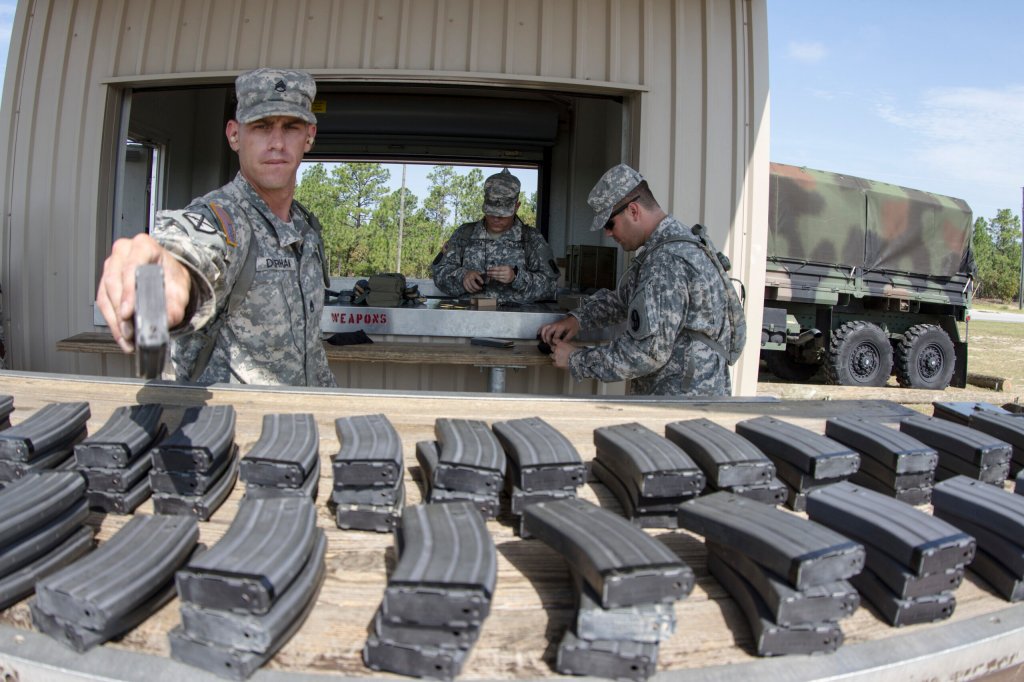The U.S. military’s basic rifleman combat loadout is 210 rounds of 5.56x45mm NATO ammo carried in seven 30-round magazines. However, if you actually inspect those magazines, you may find that many are actually only loaded with 29, 28 or even 27 rounds of ammo. While there is a practical reason for this inconsistency, it is also linked to a battlefield tall tale.

In the early 1960s, the U.S. military adopted the ArmaLite Rifle AR-15 as the M16 rifle. Chambered in the smaller .223 Remington cartridge, later standardized as 5.56x45mm NATO, it allowed troops to carry more ammunition than the heavier M14 rifle which fired the larger 7.62x51mm NATO round. Despite this, the M16 was originally issued with 20-round magazines, the same as the M14.
The first magazines issued for the M16 were steel and featured a distinct stamped waffle pattern. However, troops had issues with the function of these magazines and most of them were destroyed. The military replaced the steel magazine with an aluminum magazine that also held 20 rounds of ammunition.

Although the new aluminum magazines functioned properly with the M16, a myth began that they could only be loaded with 17-18 rounds or else the spring would weaken and cause the rifle to jam. The M16 did experience frequent stuck cases in Vietnam. In fact, troops often taped cleaning rods to their rifles to ram down the barrel and clear the malfunction. However, this wasn’t caused by filling magazines to their capacity.
Ask any engineer and they will tell you that springs don’t wear out from being compressed fully. Rather, spring wear is the result of repeatedly compressing and decompressing the spring over time. After being loaded and unloaded over the course of its service, a magazine spring will eventually lose tension and be unable to feed ammunition to the weapon properly. Still, this wasn’t the cause of the frequent M16 malfunctions. So if it wasn’t worn magazine springs, what was causing the issues?

As originally designed by Eugene Stoner, the AR-15 featured a chrome-plated chamber and barrel bore. This treatment made the weapon easier to clean and prevented debris from sticking in these critical components. However, the U.S. military opted to skip the chrome plating to save money on M16 production. As a result, humidity and other environmental factors in Vietnam led to pitting in the chambers of M16s.
When a brass-cased bullet is fired, the brass case expands in the chamber to create a seal and force the expanding gasses down the barrel. However, degraded and pitted chambers without chrome plating caused the brass to expand into those pits that would prevent the rifle from ejecting the spent case. Eventually, the military returned to Stoner’s specification and chromed the rifle’s chamber and bore.
Although modern M4 carbines receive the chrome treatment that early M16s didn’t, deployed troops still download their magazines. Brand new magazines are often issued for deployments with fresh springs that can cause malfunctions until they’re broken in. “We had new PMAGs leading up to and throughout the entirety of deployment and it always got really tight when you loaded all the rounds,” one Army infantry officer told WATM. “Usually it would send a double feed within the first one to two rounds.”
So, while the practice of downloading magazines was adopted based on a flawed understanding of the M16’s issues in Vietnam, there is still a reason that troops continue it today.


